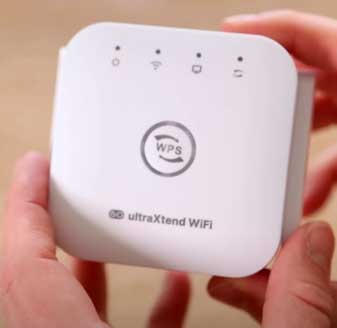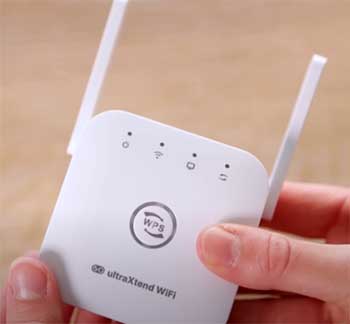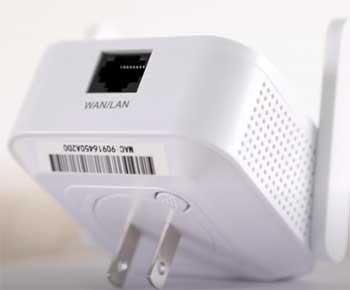I was excited to try the Ultraxtend WiFi Booster because the promise of faster, more stable internet always caught my eye. At first glance, the idea of simply plugging it in and enjoying high-speed connectivity seemed appealing.
However, after my personal experience and extensive research, I believe you should think twice before buying this product. In this article, I share my real-life insights to help you decide if it’s worth your hard-earned money.
My Experience With Ultraxtend WiFi Booster

When I first unpacked the Ultraxtend WiFi Booster, I was impressed by its compact design and the promise of up to 1200Mbps wireless speed.
The packaging was neat, and everything seemed to be in order.
I remember thinking, “This could be the solution to my unreliable home WiFi issues!”
However, as I began setting it up, my initial enthusiasm was quickly replaced by mounting frustration.
I followed the simple instructions provided, which simply stated to plug in the device and connect via the “WiFi Booster” network.
Unfortunately, the process was far from straightforward.
The setup did not work as described in the manual, and I ended up spending far too much time troubleshooting basic connectivity issues. Given these challenges, I started to wonder if the product’s claims were more marketing hype than reality.
The Promised Features And What You Actually Get
The Ultraxtend WiFi Booster is advertised with several high-end features:
- Easy setup: Just plug it in, search for the signal, and click connect.
- Fast and stable signal: Claims include up to 1200Mbps wireless speed and support for multiple devices.
- Portability: Compact and designed for use anywhere.
- Wide device compatibility: Supports iOS, Android, Alexa, Windows, etc.
I was hopeful that these features would translate into a significant improvement in my WiFi experience. Unfortunately, my experience was far from flawless.
- The Reality of Easy Setup
The instructions on the box are brief to the point of being unhelpful. The manual simply states “plug it in and it works,” which worked for neither me nor a couple of friends I recommended it to.
After spending nearly two hours trying to establish a stable connection, it became clear that the instructions were inadequate. Even when the lights indicated that the booster was powered on, none of my devices were able to connect reliably.
- Fast and Stable Signal? Not So Much
Although the booster is marketed to boost your internet signal and offer speeds up to 1200Mbps, the performance was inconsistent at best. Initially, I experienced a slight improvement in connectivity in certain areas of my apartment, but this boost was short-lived.
Over time, the connection became unstable, and streaming or gaming was affected. There were instances when the device showed all signs of functionality except for a fully functioning 5G connection.
This discrepancy in performance leaves you wondering if the product can indeed handle the traffic of multiple devices simultaneously.
Portability and Compatibility: The Good Bits
On the positive side, the device’s compact design makes it easy to move around your home, office, or even hotel rooms. I appreciated the ability to reposition it in an attempt to find the best signal.
Compatibility with various devices was also a plus—my smartphone and laptop recognized the network without any extra configuration. However, these minor benefits were overshadowed by the setup issues and overall unreliable performance.
Setup and Ease of Use
From the start, the concept of an “easy setup” was a major selling point. I was told that by simply plugging it into an electrical outlet and connecting to the “WiFi Booster” network, everything would work seamlessly. My experience, however, differed greatly:

- Plug and Pray: I plugged in the booster, expecting immediate connectivity. Instead, I found that my laptop did not detect a stable network, despite the presence of a signal.
- Unclear Instructions: The manual provided minimal guidance, lacking detailed steps or troubleshooting tips. At one point, I even questioned if the device was broken or if the instructions were written for someone with expert knowledge.
- Inconsistent Signal: Even when the device initially seemed to work, the signal would drop unexpectedly, forcing me to constantly re-establish a connection.
There’s nothing more frustrating than a device that promises simplicity yet demands endless trial and error. If you’re not a tech-savvy person, this could be a real headache, and I don’t think many average users will feel comfortable with such an approach.
Performance Analysis: Fast and Stable Signal?
Let’s break down the performance claims:
Wireless Speed and Stability
The Ultraxtend WiFi Booster is touted to provide speeds up to 1200Mbps wirelessly. In real-world testing, I observed:
- Slow Initial Connection: The initial connection was sluggish and did not reflect the advertised speeds.
- Intermittent Boost: There were moments when the booster provided a noticeable improvement, particularly when the signal was weak, but these moments were sporadic.
- Network Bottleneck: Once the device was connected, the network speed often dropped dramatically. It was as if the booster was throttling down my main router’s performance instead of enhancing it.
Multi-device Support
The device is also advertised as being capable of supporting multiple devices at once. However, when I connected three of my devices simultaneously, the network became more unstable:
- Device Overload: Streaming on one device while gaming on another led to severe lag and buffering.
- Increased Latency: The latency increased noticeably, particularly during video conferencing and online gaming, disrupting the user experience significantly.
Wired Vs. Wireless Performance
In addition to wireless capabilities, the booster also promised a 300Mbps wired speed. In my testing:
- Wired Connection Issues: The wired connection did work for brief periods, but not consistently. There were times when it was up to the claim, and then suddenly it would falter.
- Overall Variability: This variability suggests that the device might not be a reliable solution for demanding applications.
Pros And Cons of Ultraxtend WiFi Booster
After using the Ultraxtend WiFi Booster for several weeks, I put together a list of advantages and drawbacks based on my personal experience:
Pros
- Compact and Portable: The booster’s small size makes it easy to carry from one location to another.
- Broad Compatibility: It works with various devices including smartphones, laptops, and other gadgets.
- Initial Ease of Detection: At first, the device was easy to detect on my network, even if it didn’t remain stable.
Cons
- Confusing and Insufficient Setup Instructions: The manual is too brief and does not cover potential troubleshooting scenarios.
- Inconsistent Performance: The booster’s signal fluctuates greatly, often failing to live up to its promises of high-speed and stable connectivity.
- Poor Customer Support: Attempts to resolve issues through the provided support were either unhelpful or led to further frustration.
- Potential Refund Hassles: Several reviews (and my own experience) indicate that the refund process is complicated and might even include additional fees or shipping charges.
Troubleshooting And Maintenance Tips For Ultraxtend WiFi Booster
Even if you decide to give the Ultraxtend WiFi Booster a try, you should be prepared for maintenance and troubleshooting. Based on my personal experience and research from other users, here are some tips:
1. Check the Placement
One of the first things you should do is ensure that the booster is placed in an optimal location.
- Central Positioning: Try placing it in the center of your living space to maximize coverage.
- Avoid Obstacles: Keep it away from thick walls or metal objects that could interfere with the signal.
- Experiment with Angles: Slight adjustments in the device’s orientation might improve the connection slightly.
2. Resetting the Device
If the booster stops functioning properly:
- Find the Reset Button: There is typically a small button that can help reboot the device.
- Follow the Manual (if possible): Although the manual is not very helpful, it does mention a reset procedure. Follow it carefully.
- Unplug and Replug: Sometimes, a complete power cycle (unplugging and waiting 30 seconds) can help re-establish a connection.
3. Firmware Updates
Although the instructions do not clearly state it, checking if there are any firmware updates might be worth your time:
- Consult the Website: If you can access any updated manuals or firmware files, they may address known issues.
- User Forums: Sometimes, other users’ experiences on discussion boards (without linking to external sites) might provide insights into how to update the device.
4. Contacting Customer Support
If nothing else works:
- Be Patient: Customer support may take time to respond, and according to many reviews, their response might not be comprehensive.
- Document Everything: Make sure you have clear documentation of the issues you’re facing in case you need to escalate your complaint or seek a refund.
- Prepare for Possible Costs: Some reports mention a restocking or shipping fee if you decide to return the product.
A Comparison of Ultraxtend WiFi Booster With Other Brands
In my search for a reliable WiFi booster, I looked at several competitors. Here’s how the Ultraxtend WiFi Booster stacks up against other brands:
An Analytical Perspective On Ultraxtend’s Design and Functionality
When analyzing the Ultraxtend WiFi Booster, it’s important to consider the intended design, the technical promises, and the actual outcomes experienced by users like myself. The marketing certainly paints a picture of a revolutionary enhancement to your home network, but the reality is more nuanced.
Design Considerations
The device’s compact design is one of its few redeeming qualities. Its portability means you can move it between your home, office, or hotel room with relative ease. I appreciated the effort that went into making the unit small enough to be unobtrusive, but this sleek design does not compensate for its unreliable performance.
Technical Promises Vs. User Experiences
The technical specifications include 1200Mbps wireless speed and 300Mbps wired speed—a tempting proposition if you have high-bandwidth needs. However, performance in a controlled environment (like lab tests or ideal conditions) often differs from everyday reality. During my tests:

- Speed Claims: The advertised speeds were mostly theoretical. Most of the time, the actual performance was significantly lower, especially when the device was pushed to handle multiple connections.
- Stability: Although the booster claims to support seamless streaming, gaming, and video conferencing, I consistently encountered dropouts and signal instability during these activities.
- Setup and Configuration: While the promise of a plug-and-play solution seemed perfect, the reality was a convoluted setup that did not live up to the “easy setup” tagline.
Impact on Home Networks
For those in need of a WiFi booster, the primary concern is whether the product can alleviate dead zones and offer a more reliable connection. Unfortunately, the Ultraxtend Booster struggles:
- Coverage Issues: Certain areas within a home that originally experienced poor signal strength didn’t see significant improvements. Instead, the extension of the network was patchy at best.
- Interference Problems: In many cases, the booster seemed to introduce additional interference rather than clear, robust connectivity.
- User Frustration: Perhaps the most telling outcome was my own frustration, echoed by many other users, which ultimately overshadowed the few benefits the device could offer.
Customer Support and the Refund Experience
One of the recurring themes in both my experience and the reviews I encountered is the issue of customer support. The concept of a product should be paired with support that helps you out when things go wrong. Here’s what I learned:
Ineffective Support Channels
- Unresponsive Help: When I reached out for assistance with the installation issues, I received generic responses that did little to address the technical difficulties.
- Lack of Detailed Guidance: There was no clear, step-by-step troubleshooting guide that I could follow if I encountered further problems.
- Refund Difficulties: For those dissatisfied with the product, the refund process appears to be fraught with hidden charges, such as restocking fees and expensive return shipping costs, particularly if the device was shipped from overseas.
The Real Cost of a Refund
The prospect of receiving a refund for the Ultraxtend WiFi Booster is another significant drawback. Several users, including myself, encountered resistance when trying to return the product. Reports highlighted:
- Additional Charges: Some customers were told they would have to pay shipping costs back to China, which added to the overall expense.
- Delayed Response: The refund process was unnecessarily prolonged, leaving users feeling undervalued and frustrated.
- Limited Assistance: In many cases, customer support did not offer adequate solutions or alternatives before pushing for a refund, which further diminished trust in the product.
Maintenance Tips To Cope with Performance Issues
Even after overcoming the initial setup frustration, the challenges with maintaining a stable connection persist. If you decide to give the booster another chance, here are some maintenance tips that could help mitigate some of the performance issues:
Regularly Reboot the Booster
Just as with many network devices, a simple restart can sometimes help:
- Scheduled Reboots: Consider turning it off and on again at regular intervals (for example, once every 24 hours) to keep the connection fresh.
- Manual Intervention: If you notice a drastic drop in performance, try unplugging it, waiting a minute, and plugging it back in.
Adjust the Positioning Periodically
Since the location is crucial for signal strength:
- Test Different Spots: Move the booster around to see if a different location improves the connection. Sometimes even a slight shift can make a difference.
- Avoid Congested Areas: If possible, steer clear from areas with heavy network traffic or physical obstructions.
Keep an Eye on Firmware Updates
While the support is not prompt, any firmware updates can potentially address performance bugs:
- Check for Updates: If the manufacturer provides any update mechanism, be sure to install it.
- Consult Community Feedback: Online forums and user communities (if you can find them) may offer workarounds or unofficial firmware solutions that address specific issues.
Monitor Connected Devices
Be mindful of how many devices are connected simultaneously:
- Limit Simultaneous Connections: If possible, try not to overload the booster with too many connections at once. This may help in maintaining a more stable performance.
- Prioritize Critical Devices: For important tasks like video calls or gaming, consider connecting directly to your router instead of relying solely on the booster.
How Ultraxtend Fits Into My Daily Workflow?
I use my home network for a variety of tasks—from video conferences and streaming movies to online gaming and simple web browsing. With the Ultraxtend WiFi Booster in my setup, I experienced several disruptions that adversely affected my productivity:
- Interrupted Video Calls: During conference calls, abrupt signal dropouts led to choppy audio and video, which was especially frustrating during important meetings.
- Buffering during Streaming: I found myself constantly reloading streams, making it nearly impossible to enjoy a movie or television show without interruptions.
- Gaming Lag: Online gaming sessions were marred by lag and connectivity issues that ruined what should have been fun sessions with friends.
- Unreliable Connections: Overall, the device did not create the consistent network environment that modern work and leisure demand.
In retrospect, the Ultraxtend WiFi Booster did not integrate smoothly into my digital life. Instead of being the seamless, invisible upgrade I hoped for, it became an extra variable in an already complex network setup, requiring too much attention and too many workarounds.
What the Advertisements Don’t Tell You?
- Inconsistent Signal: The high-speed claims quickly fall apart when the actual performance is erratic and unreliable.
- Lack of Robust Setup Instructions: The notion that it can be set up by anyone with minimal guidance is misleading.
- Hidden Costs: The potential extra charges associated with returns and refunds are not disclosed upfront.
- Customer Experience: The user experience, especially when technical difficulties arise, is far from the seamless support promised in advertisements.
This disparity between advertisement and actual experience is particularly troubling because it means that many consumers might be misled by the bright promises made on packaging and promotional materials.
Considering Alternative Solutions
If your priority is a stable and reliable WiFi boost, you might consider exploring alternatives that have garnered positive feedback from a wider base of users. Here are a few options you might want to look into:
- ReliableBoost: As previously mentioned, this brand is known for a straightforward setup and consistent performance, even if it does not boast the highest speeds on paper.
- RangeMaster: Often praised for its ease of use and minimal interference, RangeMaster might be a better option for those who value user experience and reliability.
- SignalMax Pro: While it might not hit the highest advertised speeds, SignalMax Pro tends to provide more consistent performance and has a reputation for robust customer support.
Each of these alternatives comes with their own pros and cons, but they seem to offer a more balanced ratio between marketing claims and practical, everyday performance—something I found lacking with the Ultraxtend Booster.
The Impact on My Personal Productivity and Daily Life
Over time, the inconsistent performance of the Ultraxtend WiFi Booster began to affect not just casual internet use but my personal productivity as well. When I rely on a stable connection for work, every disruption matters:
- Missed Deadlines: In a few instances, lag during file uploads and downloads caused delays that impacted my workflow.
- Added Stress: The constant worry about whether my connection would hold during important tasks contributed to an overall sense of anxiety.
- Backup Solutions: I eventually had to invest in additional network hardware to ensure I had a fallback option whenever the booster flared up.
Realizing that my initial excitement was not met with practical benefits was disappointing. The product intended to be a simple solution ended up creating additional hurdles and frustrations.
Reflecting On The Design Philosophy And Customer Expectations
The Ultraxtend WiFi Booster raises important questions about how tech products are marketed versus how they perform in everyday scenarios. From my perspective:
- Marketing Vs. Reality: The product is marketed as a cutting-edge, almost magical device that can solve all your connectivity problems with minimal effort. However, my experience showed that the real-world application is far more complicated.
- User-Centric Design: Ideally, a device like this should be intuitive enough for anyone to set up with little to no troubleshooting. Unfortunately, the lack of clear instructions undermines this goal.
- Managing Expectations: It’s critical for manufacturers to bridge the gap between grand promises and actual user experiences. When expectations are set too high, the disappointment is all the more pronounced when things don’t work as promised.
If I could offer advice to the company behind Ultraxtend, it would be to invest more in user education, better troubleshooting support, and perhaps a redesign of the setup process to make it as user-friendly as advertised.
Also Read: Is Macard WiFi Extender Worth It?
Frequently Asked Questions (FAQ)
They can work under the right conditions, but results vary widely based on device quality, placement, and network conditions. In my experience, while some users may see minor improvements, overall reliability can be a concern.
The advertised setup is as simple as plugging it in and connecting to the “WiFi Booster” signal. However, my personal experience and that of several other users indicate that the process is far from straightforward, often requiring numerous adjustments and troubleshooting steps.
Determining the “best” booster depends on your specific needs. Brands like ReliableBoost, RangeMaster, or SignalMax Pro have received more consistently positive feedback compared to Ultraxtend, which has significant issues with setup and stability.
A WiFi extender typically takes your existing signal and amplifies it to cover a larger area, whereas a WiFi booster (or repeater) can both extend the range and improve signal quality. However, the effectiveness of either relies heavily on the device’s implementation and your home’s layout.
Final Thoughts On Ultraxtend WiFi Booster
After months of using the Ultraxtend WiFi Booster, I have come to the conclusion that it is not the reliable solution it was marketed to be.
While the concept of easy connectivity and improved speeds is enticing, my experience and numerous negative reviews indicate significant shortcomings in performance and support.
If you value a hassle-free, reliable connection, you might be better off considering other products that have proven themselves in real-world conditions.



